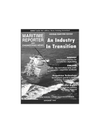
Page 26: of Maritime Reporter Magazine (September 1996)
Read this page in Pdf, Flash or Html5 edition of September 1996 Maritime Reporter Magazine
WE CALL THEM
EDUCATORS.
Watorfot Propulsion For Fast Craft
There are many challenges associated with the correct selection of waterjet propulsors for a vessel designed to perform a given mission.
When the primary purpose of the proposed new vessel has been defined — in terms of payload, range, speed, endurance, sea state and other environmental factors — the ship design pro- ceeds as an iterative process to define the opti- mum hull parameters, the optimum propulsor type and size, the internal arrangements, aux- iliary equipment and many other features. The goal: arrive at the ship design which best meets the requirements of the mission with the mini- mum financial outlay and maximum economic return.
The application of waterjet propulsion to fast commercial craft is still relatively new. The last 15 years have seen a tremendous growth in the waterjet propulsion industry, both in terms of total numbers of units supplied and in the size and power of the units themselves.
Consequently, there has been a parallel growth
DONJON MARINE CO., INC. in the number and displacement of water- jet-propelled vessels, and in the number of hull types to which waterjet propulsion may be applied. Due to the newness of the technology, the tendency has been to fit avail- able waterjet propulsors into a ship design rather than to optimize the ship and propulsor combination. The consequence has been that the true overall economic potential of a waterjet application is often not fully realized.
As with propellers, the waterjet with the high- est propulsive efficiency is not usually the best choice for a given ship design. The size and weight of the propulsors have a significant impact on the hull design and on the ultimate vessel displacement. While it may be satisfying to boast of a high propulsive efficiency, the boast is empty if the ship requires more fuel and costs more to build and operate than a slightly smaller ship that performs the same mission with propulsor that operate with a lower propulsive efficiency.
Identifying candidate-optimal designs can be done quickly by using a whole-ship design inte- gration tool, often referred to as a ship design synthesis model. Obviously, the validity of the results will depend on the accuracy of the rep- resentation of the elements which comprise the computer model of the ship. Such elements include the hull design and structure, prime movers, propulsors, auxiliary systems, fuel, payload, weapons systems (if any) and many other items.
Dcrrick Barge CHESAPEAKE 1000
SALVAGE & WRECK REMOVAL
FIRE-FIGHTING, LIGHTERING
OCEAN / COASTAL / INLAND TOWAGE
DEAD-SHIP TOW PREP
CARGO HEAVY LIFT (1,000 TON)
OCEAN / COASTAL / INLAND BARGE TRANSPORT
Phone Telex Facsimile (908)964-8812 WU 138251 (908)964-7426 1250 Liberty Ave., Hillside, New Jersey 07205, USA
Growth In Popularity
The reasons for the growth of waterjet propul- sion in recent years are many. Initially, the rea- sons were the advantages of waterjets com- pared with propellers for certain applications.
These advantages included shallow draft, absence of underwater appendages such as rud- ders, shafts and brackets, relative indepen- dence of thrust and torque from variations in ship speed, whereby propellers tend to overload engines, and reduced vibration and noise.
As the database for waterjet-propelled ships increased, it became evident that, for fast craft at least, waterjet propulsion was more efficient than conventional marine screw propulsion, largely because of the absence of appendage drag, and the development of large waterjet propulsors with high mass flow rates and jet velocities suited to ships having speeds in the 30 to 45-knot region, whereas earlier waterjets were more suited to speeds above 50 knots.
Examples of such applications include hydrofoil and surface effect ships (SES).
Waterjets enjoy considerable popularity for high-speed car and passenger ferries which operate at speeds up to 45 knots with various hull forms, including SES, catamarans, semi- planing, monohulls, and SWATH. In addition to car and passenger ferries, very large water- jets (30,000 kW and above) are being designed in conjunction with high-speed cargo vessels for trans-oceanic use with speeds up to 50 knots.
At present, the largest ships would require four or more of the largest existing waterjets, but this will change as very much larger units, 28 Maritime Reporter/Engineering News
Circle 252 on Reader Service Card
At the Center for
Maritime Education, we offer more than the latest computer simulation technology and USCG-approved courses. We give you access to a sophisticated faculty with a hundred years of maritime and simulation experience, and the know-how to put those years to work for their students.
Whether they're teaching
Bridge Resource
Management or providing insights into
GMDSS, Inland or
Coastal Tug/Barge, they offer quality training.
But what else would you expect from the center that's been helping mariners make the right decisions for over a century?
OUR BRIDGE RESOURCE MANAGEMENT PROGRAM
FEATURES UNIQUE, STATE OF THE ART, INTERACTIVE, 3 DIMENSIONAL TRAINING TOOLS.
THE CENTER FOR MARITIME EDUCATION at The Seamen's Church Institute, 241 Water Street, NYC 10038. (8 0 0 ) 5 48-7 4 28
Circle 353 on Reader Service Card

 25
25

 27
27
